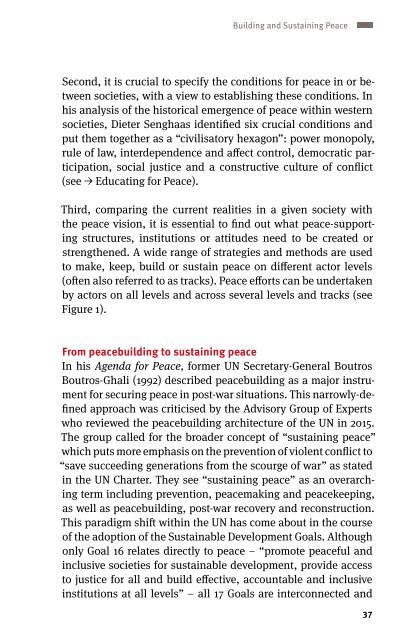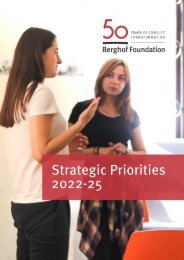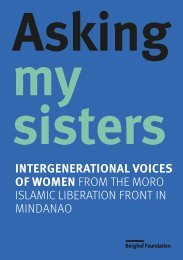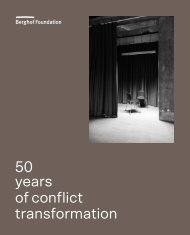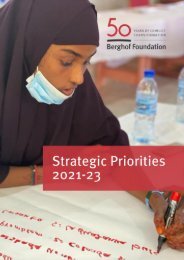Berghof Glossary on Conflict Transformation
The Berghof Glossary on Conflict Transformation presents 20 of the main principles and approaches used by the Berghof Foundation in its work. It is a concise and accessible exploration of what it takes to create “space for conflict transformation”. 2019 edition.
The Berghof Glossary on Conflict Transformation presents 20 of the main principles and approaches used by the Berghof Foundation in its work. It is a concise and accessible exploration of what it takes to create “space for conflict transformation”. 2019 edition.
You also want an ePaper? Increase the reach of your titles
YUMPU automatically turns print PDFs into web optimized ePapers that Google loves.
Building and Sustaining Peace<br />
Sec<strong>on</strong>d, it is crucial to specify the c<strong>on</strong>diti<strong>on</strong>s for peace in or between<br />
societies, with a view to establishing these c<strong>on</strong>diti<strong>on</strong>s. In<br />
his analysis of the historical emergence of peace within western<br />
societies, Dieter Senghaas identified six crucial c<strong>on</strong>diti<strong>on</strong>s and<br />
put them together as a “civilisatory hexag<strong>on</strong>”: power m<strong>on</strong>opoly,<br />
rule of law, interdependence and affect c<strong>on</strong>trol, democratic participati<strong>on</strong>,<br />
social justice and a c<strong>on</strong>structive culture of c<strong>on</strong>flict<br />
(see → Educating for Peace).<br />
Third, comparing the current realities in a given society with<br />
the peace visi<strong>on</strong>, it is essential to find out what peace-supporting<br />
structures, instituti<strong>on</strong>s or attitudes need to be created or<br />
strengthened. A wide range of strategies and methods are used<br />
to make, keep, build or sustain peace <strong>on</strong> different actor levels<br />
(often also referred to as tracks). Peace efforts can be undertaken<br />
by actors <strong>on</strong> all levels and across several levels and tracks (see<br />
Figure 1).<br />
From peacebuilding to sustaining peace<br />
In his Agenda for Peace, former UN Secretary-General Boutros<br />
Boutros-Ghali (1992) described peacebuilding as a major instrument<br />
for securing peace in post-war situati<strong>on</strong>s. This narrowly-defined<br />
approach was criticised by the Advisory Group of Experts<br />
who reviewed the peacebuilding architecture of the UN in 2015.<br />
The group called for the broader c<strong>on</strong>cept of “sustaining peace”<br />
which puts more emphasis <strong>on</strong> the preventi<strong>on</strong> of violent c<strong>on</strong>flict to<br />
“save succeeding generati<strong>on</strong>s from the scourge of war” as stated<br />
in the UN Charter. They see “sustaining peace” as an overarching<br />
term including preventi<strong>on</strong>, peacemaking and peacekeeping,<br />
as well as peacebuilding, post-war recovery and rec<strong>on</strong>structi<strong>on</strong>.<br />
This paradigm shift within the UN has come about in the course<br />
of the adopti<strong>on</strong> of the Sustainable Development Goals. Although<br />
<strong>on</strong>ly Goal 16 relates directly to peace – “promote peaceful and<br />
inclusive societies for sustainable development, provide access<br />
to justice for all and build effective, accountable and inclusive<br />
instituti<strong>on</strong>s at all levels” – all 17 Goals are interc<strong>on</strong>nected and<br />
37


